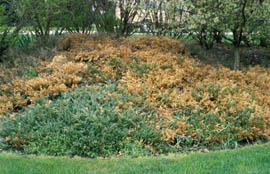Phomopsis Twig Blight of Juniper
June 6, 2007
Phomopsis twig blight of juniper is caused by the fungus Phomopsis juniperivora. Economic damage to landscape plantings and nursery stock is largely restricted to species and cultivars of juniper (Juniperus). Species of arborvitae (Thuja), cypress (Cupressus), and false cedar (Chamaecyparis) are susceptible to various degrees. Other conifers are occasionally infected. The disease is mainly a needle and shoot problem found in young plants and on the new growth of older plants.
Yellow spots at the shoot tips of young needles are the first symptoms to appear. As the infection progresses into the stems, needles turn first to pale green and then to reddish brown. Cankers, visible as grayish bands, are present at the junction of healthy and diseased tissues. These cankers girdle small stems (less than 1/3 inch in diameter), causing tip death. Dead shoots remain on the plant, eventually fading to an ash-gray color. Older branches (more than 1/3 inch in diameter) are more resistant to infection, and cankers that form on them usually heal. After 3 to 4 weeks of infection, small black spots (the fungal fruiting bodies) can be seen with the unaided eye or with a magnifying glass on the dried, ash gray parts of stems and needles. Extension specialist James Schuster took this image showing a juniper bed with damage from Phomopsis infection of stem tips.

During prolonged wet, warm periods in spring and summer (April through early June) and again in late August and September, the fungus becomes particularly infectious. It is more damaging to plants in landscape and nursery settings than it is to plants growing in the wild. Young plants and seedlings are highly susceptible and are commonly killed by the blight. This disease becomes progressively less serious as trees and shrubs grow older; and even though new growth of older plants is still susceptible, death or serious damage to a plant over 5 years old is much less likely.
The spores can tolerate some drying and may remain viable within diseased tissue for as long as 2 years. Where practical, prune out and burn, bury, or remove all blighted parts as they appear. Restrict pruning to periods of dry weather within the dry season (late June through August), to minimize spore dispersal, and also so that susceptible new growth can emerge and develop with less chance of infection. General avoidance tactics include planting in well-drained soils and avoiding overhead irrigation. If overhead irrigation is necessary, water in the early part of the day so plants dry quickly.
Several other diseases and environmental stresses may cause similar symptoms to Phomopsis twig blight. For an exact diagnosis, samples should be submitted to the Plant Clinic. To help rule out other possible causes, look for (1) death of only this year’s new growth (needles and stems); (2) a distinct line of demarcation between healthy and dis-eased tissue; (3) symptoms on plants that have not been subjected to injury, drought, or high salt levels (in soils, irrigation water, or spray from road salts).
For more information on Phomopsis twig blight of juniper, consult Report on Plant Disease,v no. 622, "Phomopsis Twig Blight of Juniper" (Adobe PDF). A print version of this report is also available in most Illinois Extension offices. See a photo gallery of symptoms at "hortanswers." (Shanyn Siegel, Plant Clinic Diagnostician)
Author: Nancy Pataky
